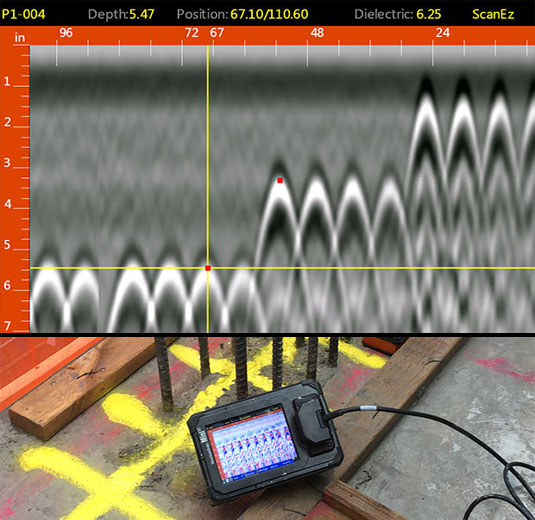Concrete Scanning: An Important Step Towards Guaranteeing Structural Stability and Safety
In the realm of building and construction and facilities maintenance, the relevance of concrete scanning can not be overstated. By using sophisticated technology and methodologies, concrete scanning offers as an essential device in making certain that the honesty and safety of buildings and bridges are maintained to the greatest standards.
Relevance of Concrete Scanning
Concrete scanning plays an important function in ensuring the architectural stability and safety of buildings and facilities projects. By making use of innovative modern technologies such as ground-penetrating radar (GPR) and electro-magnetic induction, experts can non-destructively examine concrete structures to detect prospective issues, gaps, ingrained objects, and support layout. This procedure enables early discovery of anomalies that might compromise the security of a structure, protecting against expensive problems and guaranteeing the security of residents.
Concrete scanning is particularly vital throughout the planning and building and construction phases of a job. Prior to exploration, reducing, or coring into concrete, scanning aids recognize the accurate locations of rebar, post-tension cords, and other ingrained aspects, reducing the danger of accidental hits that might bring about structural weak points. Additionally, concrete scanning help in high quality control by validating the density of concrete covers and discovering any kind of inconsistencies that might affect the general longevity of the structure. Eventually, spending in concrete scanning services is not only a positive measure to reduce threats but also an essential action in the direction of keeping the long-term safety and security of buildings and facilities.
Innovation for Concrete Examination

Benefits of Early Discovery
Prompt detection of architectural problems can considerably minimize threats and ensure the longevity of construction projects. By recognizing potential issues at an early stage in the building and construction process, stakeholders can take proactive actions to address issues before they escalate right into larger and extra expensive troubles. Among the crucial advantages of very early detection is the avoidance of architectural failures, which can posture major security risks and cause job delays and monetary losses.
Furthermore, early detection allows for prompt fixings and upkeep, which can assist prolong the lifespan of the framework. By resolving concerns immediately, building teams can stay clear of pricey repair services or even the need for early substitute of structural components. This aggressive technique not only saves money and time however also enhances the total security and resilience of the construction task.
Furthermore, early discovery can enhance project preparation and decision-making by offering stakeholders with valuable understandings into the problem of the structure. Equipped with this info, project managers can make enlightened selections relating to construction approaches, materials, and timelines, bring about extra effective and effective job end results.
Making Certain Architectural Security
Making sure the architectural security of a building and construction job is extremely important to its safety and longevity. Structural security refers to the capability of a structure or infrastructure to preserve its kind and function under ecological problems and various loads. To accomplish this, detailed evaluation and tracking of the framework are crucial. Concrete scanning plays an essential duty in guaranteeing structural security by identifying potential concerns such as voids, delamination, or reinforcement corrosion that might endanger the honesty of the structure over time.
By making use of innovative scanning technologies like ground-penetrating radar (GPR) and electro-magnetic induction, building and construction experts can non-invasively examine concrete frameworks to recognize areas of worry underneath the surface area. This positive method enables the early detection of defects or weak points, making it possible for punctual repair services or support to stop structural failures.
Routine concrete scanning throughout various building and construction phases and throughout the life cycle of a framework can help preserve its stability, reduce risks, and make sure the safety and security of occupants. By focusing on architectural stability through concrete scanning, building and construction projects can boost their resilience and sturdiness, eventually adding to higher security and durability.

Stopping Essential Failures
To guard versus devastating occasions, careful monitoring and aggressive upkeep are crucial in preventing critical failures within architectural frameworks. Spotting possible problems prior to they escalate is essential to stop architectural failings. Carrying out routine evaluations, such as concrete scanning, can disclose hidden flaws like voids, splits, or corrosion that might endanger the honesty of a his response framework. By utilizing advanced scanning innovations like Ground Passing through Radar (GPR) or Concrete X-ray, engineers can non-destructively assess the problem of concrete and recognize powerlessness that call for reinforcement or repair - RainierGPR Service Areas.

Verdict
Finally, concrete scanning plays an essential function in ensuring architectural integrity and safety by using sophisticated innovation for early detection of prospective concerns. This positive strategy assists prevent essential failings and ensures the security of structures. It is necessary to prioritize concrete examination as a standard practice to shield the durability and safety and security of buildings and framework.
Concrete scanning plays an essential duty in guaranteeing the structural honesty and safety and security of buildings and framework projects. Furthermore, concrete scanning help in quality control by validating the density of concrete covers and finding any inconsistencies that might affect the general durability of the structure. Concrete scanning plays a crucial function in making certain architectural stability by finding potential issues such as spaces, delamination, or support their explanation deterioration that can compromise the honesty of the structure over time.

In conclusion, concrete scanning plays an essential role in ensuring structural honesty and safety and security by using sophisticated innovation for early detection of potential concerns.